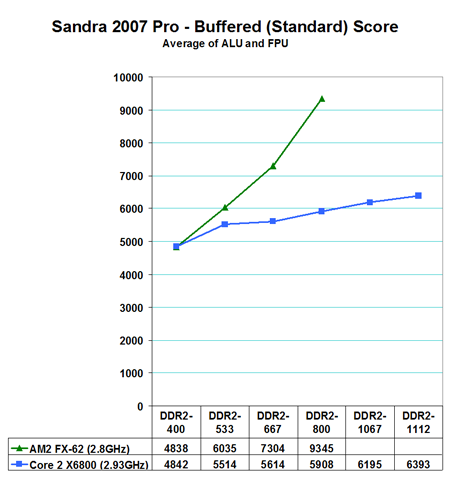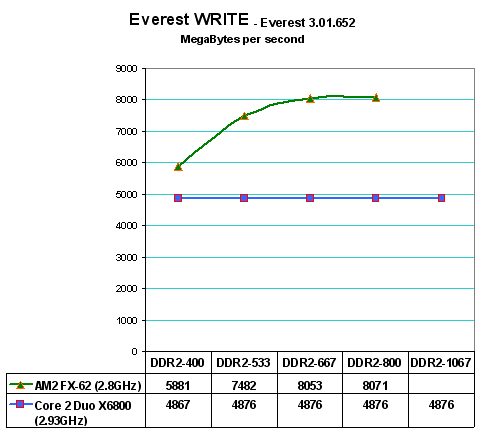Memory Bandwidth and Scaling
Everyone should already know that memory bandwidth improves with increases in memory speed and reductions in memory timings. To better understand the behavior of AM2 and Core 2 Duo memory bandwidth we used SiSoft Sandra 2007 Professional to provide a closer look at memory bandwidth scaling.

The most widely reported Sandra score is the Standard or Buffered memory score. This benchmark takes into account the buffering schemes like MMX, SSE, SSE2, SSE3, and other buffering tools that are used to improve memory performance. As you can clearly see in the Buffered result the AM2 on-chip memory controller holds a huge lead in bandwidth over Core 2 Duo. At DDR2-800 the AM2 lead in memory bandwidth is over 40%.
As we have been saying for years, however, the Buffered benchmark does not correlate well with real performance in games on the same computer. For that reason, our memory bandwidth tests have always included an UNBuffered Sandra memory score. The UNBuffered result turns off the buffering schemes, and we have found the results correlate well with real-world performance.

The Intel Core 2 Duo and AMD AM2 behave quite differently in UNBuferred tests. In these results AM2 and Core2 Duo are very close in memory bandwidth - much closer than in Standard tests. Core 2 Duo shows wider bandwidth below DDR2-800, but this will likely change when the AM2 controller matures and supports values below 3 in memory timings as the Core 2 Duo currently supports.
The Sandra memory score is really made up of both read and write operations. By taking a closer look at the Read and Write components we can get a clearer picture of how the two memory controllers operate. Everest from Lavalys provides benchmarking tools that can individually measure Read and Write operations.

The READ results are particularly interesting, since you can see that the READ component of Core 2 Duo performance is much larger than the WRITE results on Core 2 Duo. This is the result of the intelligent read-aheads in memory which Intel has used to lower the apparent latency of memory on the Core 2 Duo platform. Actual READ performance on Core 2 Duo now looks almost the same as AM2 to DDR2-533. AM2 starts pulling away in READ at DDR2-677 and has a slightly steeper increase slope as memory speed increases. The increases in READ speed in Core 2 Duo are a result of the intelligent read-aheads in memory. Performance without this feature would show Core 2 Duo much slower in READ operations than AM2.

This is most clearly illustrated by looking at Everest Write scores. Memory read-ahead does not help when you are writing memory, so core 2 Duo exhibits much lower WRITE performance than AM2 as we would expect. This means if all else were equal (and it isn't) the AM2 would perform much better in Memory Write tasks. Surprisingly the WRITE component of Core 2 Duo appears a straight line just below 5000 MB/s. AM2 starts at 5900 at DDR2-400 and WRITE rises to around 8000MB/s at DDR2-667. Write then appears to level off, with higher memory speeds having little to no impact on AM2 WRITE performance.
Everyone should already know that memory bandwidth improves with increases in memory speed and reductions in memory timings. To better understand the behavior of AM2 and Core 2 Duo memory bandwidth we used SiSoft Sandra 2007 Professional to provide a closer look at memory bandwidth scaling.

The most widely reported Sandra score is the Standard or Buffered memory score. This benchmark takes into account the buffering schemes like MMX, SSE, SSE2, SSE3, and other buffering tools that are used to improve memory performance. As you can clearly see in the Buffered result the AM2 on-chip memory controller holds a huge lead in bandwidth over Core 2 Duo. At DDR2-800 the AM2 lead in memory bandwidth is over 40%.
As we have been saying for years, however, the Buffered benchmark does not correlate well with real performance in games on the same computer. For that reason, our memory bandwidth tests have always included an UNBuffered Sandra memory score. The UNBuffered result turns off the buffering schemes, and we have found the results correlate well with real-world performance.

The Intel Core 2 Duo and AMD AM2 behave quite differently in UNBuferred tests. In these results AM2 and Core2 Duo are very close in memory bandwidth - much closer than in Standard tests. Core 2 Duo shows wider bandwidth below DDR2-800, but this will likely change when the AM2 controller matures and supports values below 3 in memory timings as the Core 2 Duo currently supports.
The Sandra memory score is really made up of both read and write operations. By taking a closer look at the Read and Write components we can get a clearer picture of how the two memory controllers operate. Everest from Lavalys provides benchmarking tools that can individually measure Read and Write operations.

The READ results are particularly interesting, since you can see that the READ component of Core 2 Duo performance is much larger than the WRITE results on Core 2 Duo. This is the result of the intelligent read-aheads in memory which Intel has used to lower the apparent latency of memory on the Core 2 Duo platform. Actual READ performance on Core 2 Duo now looks almost the same as AM2 to DDR2-533. AM2 starts pulling away in READ at DDR2-677 and has a slightly steeper increase slope as memory speed increases. The increases in READ speed in Core 2 Duo are a result of the intelligent read-aheads in memory. Performance without this feature would show Core 2 Duo much slower in READ operations than AM2.

This is most clearly illustrated by looking at Everest Write scores. Memory read-ahead does not help when you are writing memory, so core 2 Duo exhibits much lower WRITE performance than AM2 as we would expect. This means if all else were equal (and it isn't) the AM2 would perform much better in Memory Write tasks. Surprisingly the WRITE component of Core 2 Duo appears a straight line just below 5000 MB/s. AM2 starts at 5900 at DDR2-400 and WRITE rises to around 8000MB/s at DDR2-667. Write then appears to level off, with higher memory speeds having little to no impact on AM2 WRITE performance.










118 Comments
View All Comments
sld - Tuesday, July 25, 2006 - link
Yes I second the importance of a 32M run, because I want to know how Core 2 Duo does when the dataset does not fit into the L2 cache. The Intel fanboys at xtremesystems are annoying me with their whoops of glee over the 1M and 2M results.The performance difference in games and superpi is large enough to be termed anomalous, simply because superpi is a feel-happy benchmark.
Calin - Tuesday, July 25, 2006 - link
I've had the same issue on understanding the graphic - but I think it is much better now (top representing better performance, with the scale inverted)Anyway, great article!
As for the increases in cache helping AMD processors, I guess not - considering the small difference from 512k to 1M.
mattsaccount - Tuesday, July 25, 2006 - link
Never mind, I'm tired :)goinginstyle - Tuesday, July 25, 2006 - link
Page 7 is going to upset a lot of AMD fans.Page 9 index description needs to be "conclusion".
Great article and would love to see this comparison with the E6600 and E6300 CPUs against the competing AMD cpus. A lot of us will be buying these two processors and probably plain DDR2800.
OcHungry - Tuesday, July 25, 2006 - link
Can I ask you what memory timings you used?Since you have stated that memory speed does not affect conroe, would it be fair to assess that you used tightest timings for AM2?
If not: why?
About what page is going to make AMD users upset or hate the page, I totally disagree with you. You actually brought some lights to the whole scheme of things, unintentionally and unknowingly. You have helped to prove that Conroe will only be a mere 1 or 2% faster than AM2, which is not noticeable in real life situation. Conroe is only faster in Spi- But again, AMD beats Intel in memory bandwidth by a great margin. Memory bandwidth is much more important than SPI in terms of game and general cpu task(s). I will prove to everyone, that AMD is just as fast as conroe and post my reasoning in the cpu section, as soon as I have analyzed your benchmark data and made my calculations. But I need to know what memory timings you did use thu. A screenshot of timings would be great.
Again, thank you for this review that helped us open our eyes and see things in a better perspective.
Gary Key - Tuesday, July 25, 2006 - link
Wes replied earlier in the comments section but the settings are now posted on page 4 of the review.
goinginstyle - Tuesday, July 25, 2006 - link
Caluclations? I would like to see your benchmarks on actual hardware and not some scribbling on your Happy Meal napkin. I can caluclate that you are an idiot but really do not have the time to do it since I have a real life.
zsdersw - Tuesday, July 25, 2006 - link
1 or 2% faster? Please share with the rest of us what you're smoking.
Conroe is significantly faster on almost all fronts... in spite of having lower memory bandwidth.
Calin - Wednesday, July 26, 2006 - link
I suggest you to use a tractor and two trailers - one for persons and one for cargo. Even if you won't go faster than people with cars, you will have a huge bandwidth (persons and cargo bandwidth).If you buy your processor for bandwidth, choose whatever you want. If you buy it for speed, buy based on actual performance
bob661 - Tuesday, July 25, 2006 - link
I thought you didn't care about this stuff?